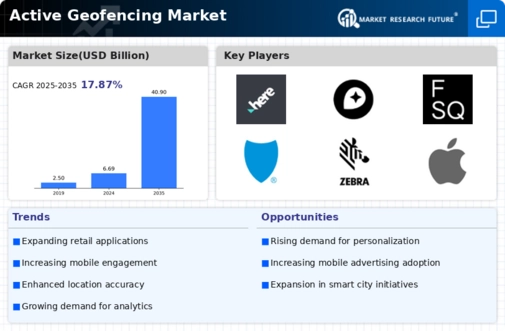Market Growth Projections
The Global Active Geofencing Market Industry is projected to experience substantial growth in the coming years. With a market value of 6.69 USD Billion in 2024, the industry is expected to expand significantly, reaching an estimated 40.9 USD Billion by 2035. This growth trajectory indicates a compound annual growth rate of 17.88% from 2025 to 2035. The increasing adoption of geofencing solutions across various sectors, coupled with advancements in technology, suggests a robust future for the market. As businesses continue to leverage geofencing for enhanced customer engagement and operational efficiency, the industry is poised for remarkable expansion.
Advancements in Mobile Technology
Technological advancements in mobile devices significantly contribute to the growth of the Global Active Geofencing Market Industry. The proliferation of smartphones equipped with GPS and advanced sensors enables businesses to implement geofencing solutions effectively. As mobile technology evolves, companies can create more sophisticated geofencing applications that offer real-time data and analytics. This capability allows businesses to tailor their marketing strategies based on consumer behavior and location. The anticipated growth trajectory, with a projected market value of 40.9 USD Billion by 2035, underscores the importance of mobile technology in shaping the future of geofencing.
Growing Focus on Customer Engagement
The Global Active Geofencing Market Industry is driven by a growing focus on customer engagement strategies among businesses. Companies are increasingly recognizing the value of personalized marketing and customer interactions facilitated by geofencing technology. By creating virtual boundaries, businesses can engage customers with tailored messages and offers based on their location. This targeted approach not only enhances customer satisfaction but also fosters brand loyalty. As organizations prioritize customer-centric strategies, the market is poised for substantial growth, aligning with the projected increase in market value to 40.9 USD Billion by 2035.
Rising Demand for Location-Based Services
The Global Active Geofencing Market Industry experiences a notable increase in demand for location-based services. Businesses across various sectors, including retail and logistics, leverage geofencing technology to enhance customer engagement and operational efficiency. For instance, retailers utilize geofencing to send targeted promotions to customers' mobile devices when they enter a defined geographic area. This approach not only boosts foot traffic but also drives sales. The market is projected to reach 6.69 USD Billion in 2024, reflecting the growing reliance on geolocation technologies to improve customer experiences and streamline operations.
Increased Adoption of Smart City Initiatives
The Global Active Geofencing Market Industry is also influenced by the rising adoption of smart city initiatives worldwide. Governments and urban planners are increasingly integrating geofencing technology into city infrastructure to enhance public services and improve urban mobility. For example, geofencing can be utilized to manage traffic flow, monitor public transportation, and ensure efficient waste management. As cities become smarter, the demand for geofencing solutions is expected to grow, potentially leading to a compound annual growth rate of 17.88% from 2025 to 2035. This trend highlights the role of geofencing in creating more efficient and sustainable urban environments.
Regulatory Support for Geolocation Technologies
Regulatory support for geolocation technologies plays a crucial role in the expansion of the Global Active Geofencing Market Industry. Governments are increasingly recognizing the potential of geofencing to enhance public safety, improve transportation systems, and support economic development. Policies that promote the use of geolocation technologies can facilitate the adoption of geofencing solutions across various sectors. This supportive regulatory environment encourages businesses to invest in geofencing technologies, thereby driving market growth. As the industry evolves, regulatory frameworks will likely adapt to accommodate the advancements in geofencing applications.
























